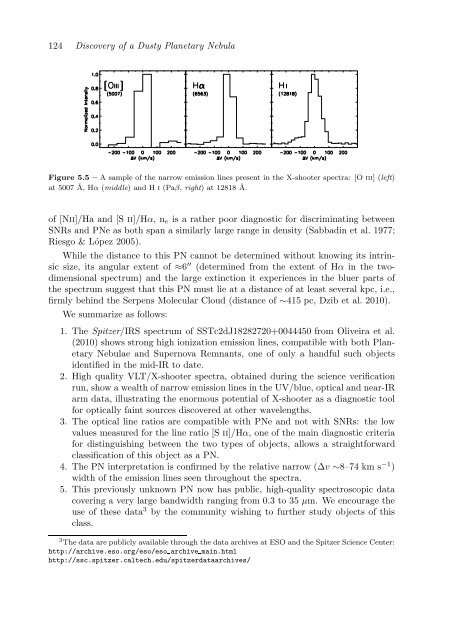Observational Constraints on The Evolution of Dust in ...
Observational Constraints on The Evolution of Dust in ...
Observational Constraints on The Evolution of Dust in ...
Create successful ePaper yourself
Turn your PDF publications into a flip-book with our unique Google optimized e-Paper software.
124 Discovery <strong>of</strong> a <strong>Dust</strong>y Planetary Nebula<br />
Figure 5.5 – A sample <strong>of</strong> the narrow emissi<strong>on</strong> l<strong>in</strong>es present <strong>in</strong> the X-shooter spectra: [O iii] (left)<br />
at 5007 Å, Hα (middle) and H i (Paβ, right) at 12818 Å.<br />
<strong>of</strong> [Nii]/Ha and [S ii]/Hα, n e is a rather poor diagnostic for discrim<strong>in</strong>at<strong>in</strong>g between<br />
SNRs and PNe as both span a similarly large range <strong>in</strong> density (Sabbad<strong>in</strong> et al. 1977;<br />
Riesgo & López 2005).<br />
While the distance to this PN cannot be determ<strong>in</strong>ed without know<strong>in</strong>g its <strong>in</strong>tr<strong>in</strong>sic<br />
size, its angular extent <strong>of</strong> ≈6 ′′ (determ<strong>in</strong>ed from the extent <strong>of</strong> Hα <strong>in</strong> the twodimensi<strong>on</strong>al<br />
spectrum) and the large ext<strong>in</strong>cti<strong>on</strong> it experiences <strong>in</strong> the bluer parts <strong>of</strong><br />
the spectrum suggest that this PN must lie at a distance <strong>of</strong> at least several kpc, i.e.,<br />
firmly beh<strong>in</strong>d the Serpens Molecular Cloud (distance <strong>of</strong> ∼415 pc, Dzib et al. 2010).<br />
We summarize as follows:<br />
1. <strong>The</strong> Spitzer/IRS spectrum <strong>of</strong> SSTc2dJ18282720+0044450 from Oliveira et al.<br />
(2010) shows str<strong>on</strong>g high i<strong>on</strong>izati<strong>on</strong> emissi<strong>on</strong> l<strong>in</strong>es, compatible with both Planetary<br />
Nebulae and Supernova Remnants, <strong>on</strong>e <strong>of</strong> <strong>on</strong>ly a handful such objects<br />
identified <strong>in</strong> the mid-IR to date.<br />
2. High quality VLT/X-shooter spectra, obta<strong>in</strong>ed dur<strong>in</strong>g the science verificati<strong>on</strong><br />
run, show a wealth <strong>of</strong> narrow emissi<strong>on</strong> l<strong>in</strong>es <strong>in</strong> the UV/blue, optical and near-IR<br />
arm data, illustrat<strong>in</strong>g the enormous potential <strong>of</strong> X-shooter as a diagnostic tool<br />
for optically fa<strong>in</strong>t sources discovered at other wavelengths.<br />
3. <strong>The</strong> optical l<strong>in</strong>e ratios are compatible with PNe and not with SNRs: the low<br />
values measured for the l<strong>in</strong>e ratio [S ii]/Hα, <strong>on</strong>e <strong>of</strong> the ma<strong>in</strong> diagnostic criteria<br />
for dist<strong>in</strong>guish<strong>in</strong>g between the two types <strong>of</strong> objects, allows a straightforward<br />
classificati<strong>on</strong> <strong>of</strong> this object as a PN.<br />
4. <strong>The</strong> PN <strong>in</strong>terpretati<strong>on</strong> is c<strong>on</strong>firmed by the relative narrow (∆v ∼8–74 km s −1 )<br />
width <strong>of</strong> the emissi<strong>on</strong> l<strong>in</strong>es seen throughout the spectra.<br />
5. This previously unknown PN now has public, high-quality spectroscopic data<br />
cover<strong>in</strong>g a very large bandwidth rang<strong>in</strong>g from 0.3 to 35 µm. We encourage the<br />
use <strong>of</strong> these data 3 by the community wish<strong>in</strong>g to further study objects <strong>of</strong> this<br />
class.<br />
3 <strong>The</strong> data are publicly available through the data archives at ESO and the Spitzer Science Center:<br />
http://archive.eso.org/eso/eso archive ma<strong>in</strong>.html<br />
http://ssc.spitzer.caltech.edu/spitzerdataarchives/
















